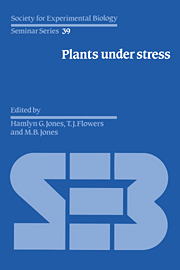Book contents
- Frontmatter
- Contents
- Contributors
- Preface
- 1 Introduction: some terminology and common mechanisms
- 2 The impact of environmental stresses on ecosystems
- 3 Whole-plant responses to stress in natural and agricultural systems
- 4 Photosynthesis and gas exchange
- 5 Regulation of growth and development of plants growing with a restricted supply of water
- 6 Stresses, membranes and cell walls
- 7 Desiccation injury, anhydrobiosis and survival
- 8 Molecular biology: application to studies of stress tolerance
- 9 Environmental control of gene expression and stress proteins in plants
- 10 Plant tissue and protoplast culture: applications to stress physiology and biochemistry
- 11 Breeding methods for drought resistance
- 12 Selection for physiological characters – examples from breeding for salt tolerance
- 13 Prospects for improving crop production in stressful environments
- Index
13 - Prospects for improving crop production in stressful environments
Published online by Cambridge University Press: 16 March 2010
- Frontmatter
- Contents
- Contributors
- Preface
- 1 Introduction: some terminology and common mechanisms
- 2 The impact of environmental stresses on ecosystems
- 3 Whole-plant responses to stress in natural and agricultural systems
- 4 Photosynthesis and gas exchange
- 5 Regulation of growth and development of plants growing with a restricted supply of water
- 6 Stresses, membranes and cell walls
- 7 Desiccation injury, anhydrobiosis and survival
- 8 Molecular biology: application to studies of stress tolerance
- 9 Environmental control of gene expression and stress proteins in plants
- 10 Plant tissue and protoplast culture: applications to stress physiology and biochemistry
- 11 Breeding methods for drought resistance
- 12 Selection for physiological characters – examples from breeding for salt tolerance
- 13 Prospects for improving crop production in stressful environments
- Index
Summary
Introduction
In recent years the term ‘stress’ has been used in an uncritical and non-specific way by administrators of agricultural and plant research, and by some plant physiologists, plant breeders, and molecular biologists. As a consequence, the view is often propagated that crop varieties may ‘soon’ be produced which will be much more stress resistant or stress tolerant than those presently grown. In this concluding chapter, I shall urge caution over this optimistic view before drawing attention to objectives which it may be possible to achieve.
Stress – a normal condition of plants
In common with all living organisms, plants have to acquire the materials from which they are made from their surroundings. In the case of plants this acquisition usually has to be made against a concentration gradient. For land plants, tissue water has to be retained as well as acquired against gradients of water potential which can vary from small, as in humid tropical forests, to very large, as in hot, dry deserts. The concentrations of many essential ions in plants are often a thousand-fold greater than those in the soil solution from which their roots extract these ions. In the sense that plants have to expend metabolic energy to acquire their resources and invest in structures to acquire and conserve them in the face of limited supply, stress is a normal condition of plants, though of variable severity. Commonly, plants are considered to be under stress when they experience a relatively severe shortage of an essential constituent or an excess of a potentially toxic or damaging substance.
- Type
- Chapter
- Information
- Plants under StressBiochemistry, Physiology and Ecology and their Application to Plant Improvement, pp. 235 - 248Publisher: Cambridge University PressPrint publication year: 1989
- 7
- Cited by



